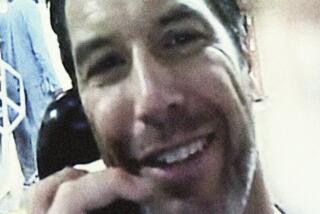Prosecutors finish bulk of case against Spector
- Share via
Prosecutors in the Phil Spector murder trial completed the bulk of their case Monday after eight weeks of testimony in which a string of women gave vivid accounts of threats at gunpoint by the defendant, and forensics experts suggested that the famous record producer shot actress Lana Clarkson, then attempted a coverup.
Spector’s attorneys are set to begin their defense this week, although prosecutors are not yet finished calling all of their witnesses. One of those witnesses, former Spector attorney Sara Caplan, was cited for contempt of court for refusing to testify before the jury, and plans to plead her case to the California Supreme Court.
Los Angeles County Superior Court Judge Larry Paul Fidler said he will stay the order to jail Caplan until 3 p.m. Thursday. If the Supreme Court has not ruled by then, Caplan must testify or surrender to be held in custody.
The other remaining prosecution witness, Los Angeles County sheriff’s criminalist Lynne Herold, faces final defense questions this morning, after two days of tough cross-examination.
Clarkson, 40, was shot to death in Spector’s Alhambra mansion Feb. 3, 2003. She was found slumped in a chair in the foyer of the castle-like home, clad in a black slip dress, her purse hanging from her shoulder. Tooth fragments were found on the outside of the gun barrel, indicating that the weapon was in her mouth when the gun was fired.
Spector and Clarkson were the only ones in the house. They had met that night at the House of Blues in West Hollywood, where Clarkson worked as a hostess.
Spector, who has been free on bail, says that Clarkson, her acting career fading, shot herself.
The prosecution stuck to the narrative Deputy Dist. Atty. Alan Jackson laid out in his April opening statement: Spector, when drunk and spurned, “turns sinister and deadly.”
“The evidence is going to paint a picture of a man who on Feb. 3, 2003, put a loaded pistol in Lana Clarkson’s mouth, inside her mouth, and shot her to death,” Jackson said.
Jackson called Clarkson “simply the last in a very long line of women who had been victimized by Phillip Spector over the years.”
He and co-counsel Pat Dixon called four women who testified that Spector threatened them at gunpoint when they rejected his advances. They included a former manager for comedian Joan Rivers, a freelance photographer, a former assistant to Spector and a waitress. Two of the women said they had been romantically involved with Spector.
All four said Spector held them at gunpoint when they rejected him. Three said he pulled guns on them when they tried to leave his home; one said Spector threatened her at the Carlyle Hotel in New York when she refused to spend the night in his suite.
Prosecutors said Spector followed the same script with Clarkson that he used with the other women, with one exception: He pulled the trigger.
The four women were followed on the witness stand by Spector’s driver, Adriano DeSouza, who testified that his boss emerged from the house after the gunshot and said, “I think I killed somebody.”
The defense sought to show that DeSouza, an admitted illegal immigrant from Brazil, was hampered by poor English and was mistaken when he asserted that Spector said he killed someone.
But DeSouza stood up to days of cross-examination without veering from his story, and expressed himself confidently in English. He even impersonated Spector’s voice at one point, which prompted an eruption of laughter from the jury.
In early May, the prosecution was sidetracked when a former law clerk to Robert Shapiro, Spector’s first attorney, came forward to say he believed the defense had hidden a piece of evidence from prosecutors. In a hearing without jurors present, Caplan testified that she saw defense expert Henry Lee holding a fingernail-sized object as the defense searched Spector’s home the night after Clarkson’s death.
Despite vehement denials by Lee, Fidler ruled that the famed criminalist had withheld an item from prosecutors, violating evidence rules, although the judge said he could not say what the object was. Fidler ruled that prosecutors could call Caplan and others to testify about the item, which prosecutors say was a piece of one of Clarkson’s acrylic fingernails, blown off by the bullet that killed her. The nail fragment could show that her hand was in front of her face, and thus she could not have pulled the trigger to shoot herself.
Caplan later refused to testify before the jury, leading to the current standoff.
The final phase of the prosecution’s case has been forensic evidence. Herold, the county criminalist, testified that Clarkson’s body was moved, presumably by Spector, after she was shot. “Blood doesn’t flow uphill, it also doesn’t fly around corners,” Herold said of what she found at the crime scene.
Herold said Clarkson’s face, and the gun with which she was shot, appeared to have been wiped. And Clarkson’s purse, she said, was hung backward on her shoulder, suggesting perhaps someone else put it there.
Most important, Herold testified that bloodstains on Spector’s jacket indicated that he was standing no more than 3 feet to 4 feet from Clarkson when she was shot.
The defense contends that the size and pattern of the bloodstains could show that Spector was standing as far as 7 feet from Clarkson -- too far to have been holding the gun inside her mouth when it went off. Much of Herold’s cross-examination by Spector attorney Linda Kenney Baden was consumed by exchanges over how far blood drops can fly.
Kenney Baden cited scientific studies showing that blood can travel farther than three feet if a gun is fired in a person’s mouth, causing a violent explosion of gases. Herold flatly questioned whether the experiments cited, such as firing a bullet into a blood-soaked sponge, could apply to a real-world case.
More to Read
Sign up for Essential California
The most important California stories and recommendations in your inbox every morning.
You may occasionally receive promotional content from the Los Angeles Times.













